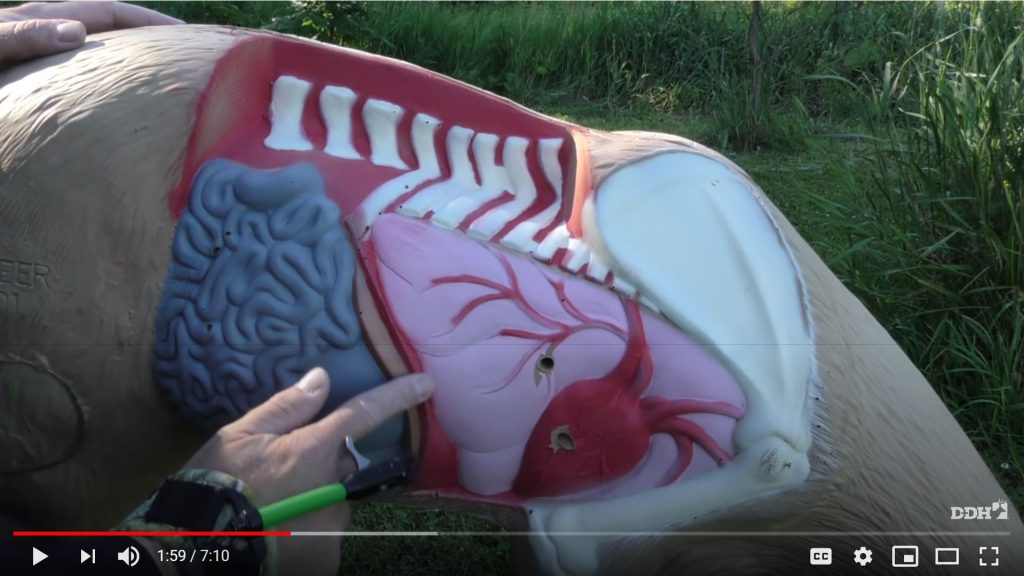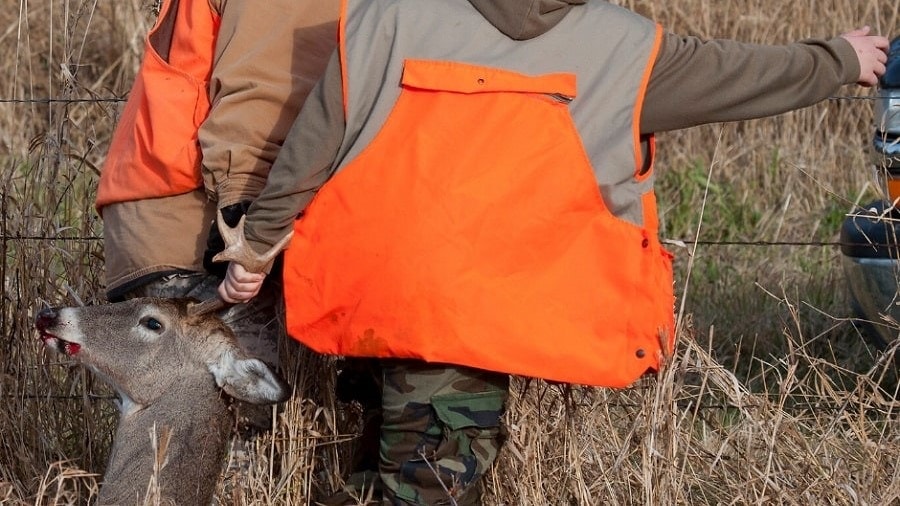Bowhunting for deer, whether from a treestand or a ground blind, is undeniably exciting. There is little in life as thrilling as attempting to remain undetected while drawing your bow when a woods-wise buck stands only yards away.
However, the flip side is that disheartening misses and instances of less than desirable shot placement occasionally occur.
As ethical bowhunters, we always strive to make every shot count and attempt to take game as cleanly as possible. The first step to this process is knowing and understanding where to shoot a deer with a bow.
Contents (Jump to Topic)
ToggleThis is not a difficult topic to grasp but should carry ample consideration every time an archer attempts a shot.
Understanding Deer Anatomy
You must first understand a deer’s anatomy to execute a clean, ethical, and effective shot with archery equipment. A deer’s vitals are roughly the front ⅓ of its body.
The front of a deer’s lungs begins in the area that is squarely between both front shoulders. The lungs then run rearward behind the shoulders for several inches.
A deer’s heart can be found in close proximity to the front of the lungs, but slightly lower in the chest.
The liver is situated to the rear of the lungs and protrudes a few inches to the rear in an area relatively near the body’s center point.
Directly behind the liver, the stomach and intestines run rearward for the remaining length of the deer’s body cavity.
In terms of lethality, a bowhunter should always strive to aim for the heart/lung area. This results in a quick, efficient kill.
When an arrow slices through this region, a deer seldom travels more than 100 yards before expiring, and the resulting blood trail is typically very easy to follow.
A hit to the liver, while always fatal, results in slower expiration and an often poor blood trail. If a deer is shot in the stomach or intestines, it will die, but significant time will pass before it does so.
read.. how to whiten a deer skull
Deer that have been shot in this manner can live as many as 12 hours following being wounded and usually expire from infection within the body cavity, as opposed to blood loss.
Best Possible Arrow Placement
When striving to place your arrow most efficiently, there is no substitute for the classic broadside shot.

When a deer is standing broadside, a wider target is presented, and an archer is given slightly more room for error.
When taking a broadside shot, an archer should aim for the area directly behind the onside front shoulder.
In this position, if an archer’s arrow strikes slightly rearward, the back of the lungs and liver are penetrated.
Likewise, if the arrow strikes forward of its mark, the front of the lungs and heart are hit (read.. tactics for rut hunting success).
Where is a Deer’s Heart Located?
The precise location of a deer’s heart and lungs can be found in alignment with the middle of its front leg. The deer’s heart, measuring approximately four inches in height, is positioned at this point, with the top of the heart resting at the midway point between its back and belly.
Even marginally high/low shots will still result in a quick, clean kill.
However, care should be taken to avoid hitting too far forward. A deer’s shoulder bone is extremely hard, and an unpredictable outcome can result if struck.
Direct shoulder hits often lead to a lack of penetration, though this is not the case in every situation.
For this reason, a shot that hits slightly rearward is often a better-unintended outcome than that of hitting significantly forward.
Alternate Forms Of Shot Placement
Second, only to the broadside shot in terms of desirability, is the slightly quartering away shot. When a deer is facing at a slight angle away from you, a relatively large area of the vitals is exposed.
When shooting at this angle, it is important to imagine the trajectory of your arrow. Prior to the shot, visualize where you must aim along a deer’s side, for the arrow to exit just behind the offside shoulder.
Because an arrow drives toward a deer’s vitals during a quartering-away shot, some room for error exists, with the odds of a probable outcome still favorable.
However, it is best to avoid shots at hard quartering angles, as an arrow can be deflected by a rib bone or glance off of a deer’s side.
Typically, a bowhunter should avoid taking quartering-away shots if the deer’s angle of orientation away from the archer is greater than 45 degrees.
What To Do When A Shot Doesn’t Go As Planned
Try as we might, the chance of less-than-desirable shot placement cannot be eliminated. Poor shots occur from time to time when shooting at game, and it is our responsibility as ethical hunters to make every effort to recover a deer that has been shot in this manner.
Much of one’s ability to find success in doing so is based upon knowing what to do after the shot.
If you are reasonably sure your shot has gone astray, the following steps should be taken.
Analyze The Shot:
After you have released your arrow, do anything to discern the point of injury to the deer that was shot.
As a deer runs from the area moments after the shot, look for visible signs of blood along the body line.
Gauge The Reaction:
Knowing how well a deer has been hit comes down to reading body posture and overall reaction.
Deer that are hit in the heart typically run hard and low to the ground, while deer hit through the lungs will generally run in a steady yet direct path.
On the contrary, deer shot through the stomach often slowly walk or gait in the direction of safety after a short running period.
Recover Your Arrow:
Your arrow is another solid indicator of the point of impact. An arrow coated in bright red blood typically indicates a lung or heart shot, while an arrow that smells foul and is coated in a green/brown substance indicates a stomach hit.
Follow Up Wisely:
Timing is everything when following a blood trail. Even if you are reasonably certain of a good shot, wait at least 1 hour before taking the trail.
If a liver or stomach hit is suspected, give the deer at least 8 hours to expire. Most deer shot in this area will bed close by.
Taking up the trail too early will likely jump a deer from its bed and make recovery nearly impossible. If a blood trail runs cold and no other blood can be found, check for signs around nearby water sources.
Deer hit in the stomach, usually spike a fever before death and seek out water.
Making Your Shot Count
As bowhunters, we are responsible to the animals we hunt to always strive for a clean, efficient, and ethical kill.
By knowing the anatomy of the game you hunt and educating yourself on proper shot placement, you take a big step toward fulfilling this duty.
Armed with the proper knowledge and a quiver full of arrows, you will be well on your way to filling your deer tag and providing your family with wonderful table fare.
If you want to learn more about attracting deer, read our article about why planting turnips for deer could be a way to do so.
FAQ
Q: What is the best shot to take on a deer?
Q: What are the deer vitals?
Q: What should I do if I hit a deer in the shoulder?
Q: What is the best shot to take with a bow?
Q: Where are the deer vitals?
Q: What if I shoot the deer while it is broadside?
Q: What is a liver shot, and how does it affect a deer?
A: A liver shot will be fatal for a deer, but the expiration process takes longer than a heart or lung shot due to the slower rate of blood loss from the liver.






